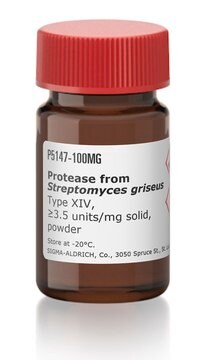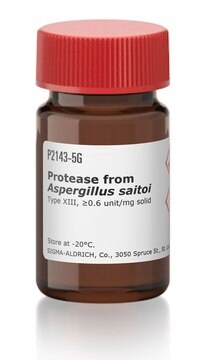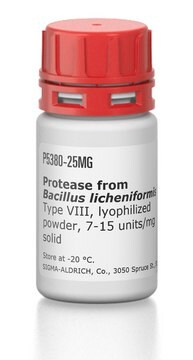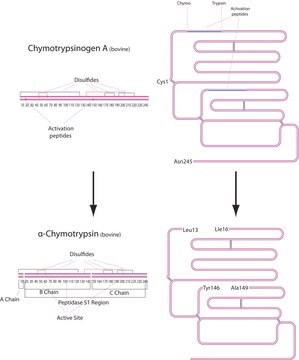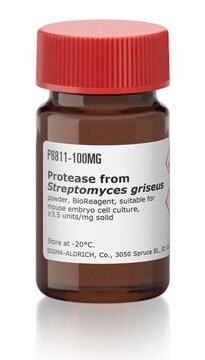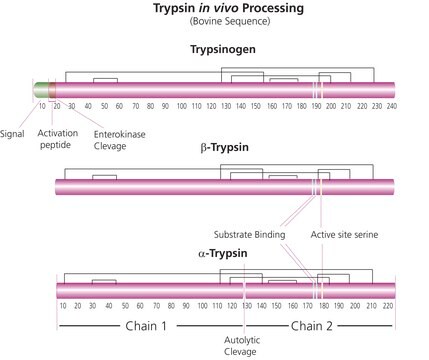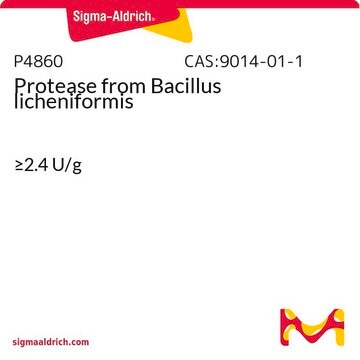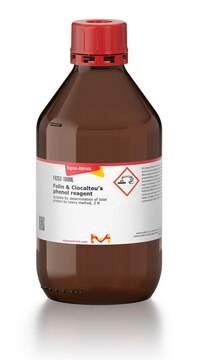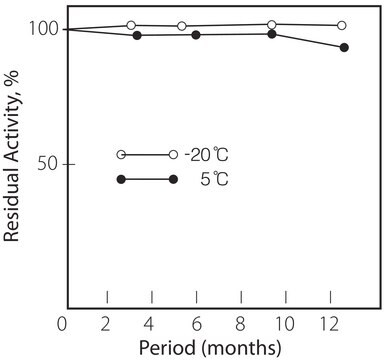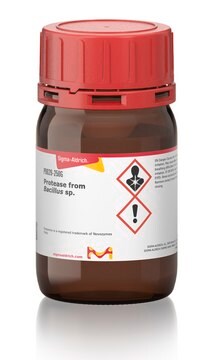Wszystkie zdjęcia(4)
Kluczowe dokumenty
P4630
Protease from bovine pancreas
Type I, ≥5 units/mg solid
Zaloguj sięWyświetlanie cen organizacyjnych i kontraktowych
About This Item
Numer CAS:
Numer WE:
Numer MDL:
Kod UNSPSC:
12352204
eCl@ss:
32160410
NACRES:
NA.54
Polecane produkty
pochodzenie biologiczne
bovine pancreas
Poziom jakości
typ
Type I
Formularz
powder
aktywność właściwa
≥5 units/mg solid
temp. przechowywania
−20°C
Powiązane kategorie
Zastosowanie
Protease is an enzyme used to break down proteins by hydrolyzing peptide bonds. Protease is used to degrade proteins, to study protease inhibitors and to study thermal inactivation kinetics. Product P4630 is from bovine pancreas. Protease from bovine pancrease (type I) has been used for the extraction of hemicellulose.
Działania biochem./fizjol.
Protease catabolizes proteins by hydrolysis of peptide bonds. Proteases are inactivated by serine active-site inhibitors, such as phenylmethylsulfonyl fluoride (PMSF) and diisopropylfluorophosphate.
Jakość
Crude
Definicja jednostki
One unit will hydrolyze casein to produce color equivalent to 1.0 μmole (181 μg) of tyrosine per min at pH 7.5 at 37 °C (color by Folin-Ciocalteu reagent), unless otherwise indicated.
Ta strona może zawierać tekst przetłumaczony maszynowo.
Hasło ostrzegawcze
Danger
Zwroty wskazujące rodzaj zagrożenia
Zwroty wskazujące środki ostrożności
Klasyfikacja zagrożeń
Eye Irrit. 2 - Resp. Sens. 1 - Skin Irrit. 2 - STOT SE 3
Organy docelowe
Respiratory system
Kod klasy składowania
11 - Combustible Solids
Klasa zagrożenia wodnego (WGK)
WGK 1
Temperatura zapłonu (°F)
Not applicable
Temperatura zapłonu (°C)
Not applicable
Środki ochrony indywidualnej
dust mask type N95 (US), Eyeshields, Faceshields, Gloves
Wybierz jedną z najnowszych wersji:
Masz już ten produkt?
Dokumenty związane z niedawno zakupionymi produktami zostały zamieszczone w Bibliotece dokumentów.
Klienci oglądali również te produkty
P A Hedin et al.
The Journal of nutrition, 124(12), 2458-2465 (1994-12-01)
The southwestern corn borer, Diatraea grandiosella Dyar, is a major pest of corn, Zea mays L., in the southern United States. To search for plant allelochemicals, chemically defined insect diets are commonly used, but southwestern corn borer larvae did not
Werend Boesmans et al.
Glia, 67(6), 1167-1178 (2019-02-08)
Coordination of gastrointestinal function relies on joint efforts of enteric neurons and glia, whose crosstalk is vital for the integration of their activity. To investigate the signaling mechanisms and to delineate the spatial aspects of enteric neuron-to-glia communication within enteric
Marc Machnik et al.
Drug testing and analysis, 9(9), 1372-1384 (2016-09-24)
Methylxanthines positives in competition samples have challenged doping control laboratories and racing jurisdictions since methylxanthines are naturally occurring prohibited substances and often constituents of feed. For theobromine, an international threshold (renamed in International Residue Limit, IRL) of 2 µg/mL in urine
Nir Qvit et al.
Pharmaceuticals (Basel, Switzerland), 15(3) (2022-03-27)
Myocardial infarction is the leading cause of cardiovascular mortality, with myocardial injury occurring during ischemia and subsequent reperfusion (IR). We previously showed that the inhibition of protein kinase C delta (δPKC) with a pan-inhibitor (δV1-1) mitigates myocardial injury and improves
U Klöckner
Pflugers Archiv : European journal of physiology, 424(3-4), 231-237 (1993-08-01)
Calcium-activated chloride currents were studied by the patch-clamp technique in vascular smooth muscle cells (VSMC) isolated from human mesenteric arteries. Bath application of 20 mM caffeine caused the cell membrane to depolarize by a calcium-activated inward current that peaked to
Protokoły
To standardize a procedure for the enzymatic assay of Protease using Casein as a substrate.
Nasz zespół naukowców ma doświadczenie we wszystkich obszarach badań, w tym w naukach przyrodniczych, materiałoznawstwie, syntezie chemicznej, chromatografii, analityce i wielu innych dziedzinach.
Skontaktuj się z zespołem ds. pomocy technicznej